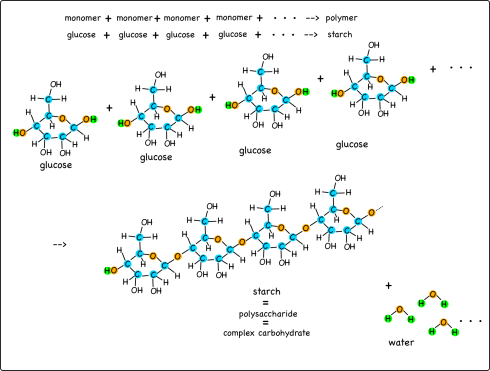As an exercise to transition from ecology to biochemistry in Biology class, I had students follow the energy from the Sun to humans via potatoes. After all, we’ve been putting together food webs, following energy through the food chain, and now I want to start talking about the short and long chained biochemical molecules like glucose and starch, at least at a general level.

So, we start with photosynthesis. The leaves of the potato plant capture sunlight and combine water and carbon dioxide to produce glucose with oxygen as a by-product.
![]()
This reaction takes radiative energy from the Sun, and stores it as chemical energy in the bonds of the glucose molecule.

Glucose is a simple sugar, one of the basic carbohydrate molecules (my bio class has not done the testing for carbohydrates yet, but we will soon). Simple carbohydrates are monomers that can be chained together to produce more complex molecules.

The potato plant chains together a series of glucose molecules it produces by photosynthesis into long chained polymers called starches. Starches are good for long-term storage of the energy because, for one thing, they don’t dissolve in water the way glucose does. (A good metaphor for this might be to have students carry a handful of beads to represent a bunch of glucose molecules versus carrying a string of beads to represent the starch).

The large stash of energy consolidated into the starch is an inviting target for animals like humans. We eat things like potatoes to get the starches, only we usually refer to them by their other name, carbs. Carbs are short for complex carbohydrates: since glucose is a simple carbohydrate, a chain of glucoses is called a complex carbohydrate. This is why people on low-carb diets try to avoid foods like potatoes.
For those of us who do eat potatoes, however, we need to break the starches down into their constituent glucose molecules to get the energy. When we eat potatoes, we chew (masticate) them to break down the cell walls and expose the starches to the enzymes, like amylase in our saliva, that breaks apart the long carbohydrate chains into simple glucose molecules. Enzymes, like amylase, are catalysts. Catalysts are substances that accelerate a chemical reaction, but are not used up in the process.
The body extracts these glucose molecules from the digested food in the small intestines. The glucose is absorbed through the small, finger-like, capillary-filled villi that line the small intestines, and gets into the blood plasma. The circulatory system transports the glucose in the plasma to cells throughout the body.
Cells use the glucose for energy by reversing the photosynthesis reaction, in a reaction called respiration:
![]()
So the cells use respiration to liberate the energy the potato plant captured from the Sun.
Teachers’ Note
I very much liked how this exercise worked. Trying to follow the energy through the plant and human, while using as much biological vocabulary as possible, really worked to integrate our discussions of anatomy and ecology, and helped introduce biochemistry. I think I’ll try other exercises like this, where students try to follow a specific atom through the human body or through the environment (as we study global biogeochemical cycles). It might also be useful to use this as an example of how isotopic tracers work.
